Motion Adsorption Characteristics of Particulate Matter in Water Supply Network
Abstract
1. Introduction
2. Materials and Methods
2.1. Experimental Contents
2.2. Laboratory Velocity and Particles Adsorb Metal Ions Experiment
3. Results
3.1. Correlation between Particulate Matter and Turbidity
3.2. Analysis of Microscopic Characteristics of Particulate Matter in Water Supply Network
3.3. Adsorption of Particulate Matter and Metal Elements
3.3.1. Adsorption of Ultra-Filtration Effluent Particles and Metal Elements in Advanced Treatment Process
3.3.2. Adsorption of Effluent Particles and Metal Elements by Conventional Treatment Process
3.4. Effect of Flow Rate on Metal Adsorption of Water Particles in Conventional Treatment
4. Conclusions
Author Contributions
Funding
Institutional Review Board Statement
Informed Consent Statement
Data Availability Statement
Conflicts of Interest
References
- Mi, Z.L.; Zhang, X.J.; Wu, H.T.; Chen, C.; Wang, J. Control of release of corrosion products caused by water source switch in drinking water distribution systems. China Water Wastewater 2013, 29, 44–48. [Google Scholar]
- Liu, G.; Zhang, Y.; Knibbe, W.-J.; Feng, C.; Liu, W.; Medema, G.; van der Meer, W. Potential impacts of changing supply-water quality on drinking water distribution: A review. Water Res. 2017, 116, 135–148. [Google Scholar] [CrossRef] [PubMed]
- Lin, X.; Xu, Q.; Li, Y.; Zhao, B.; Li, L.; Qiang, Z. Modeling iron release from cast iron pipes in an urban water distribution system caused by source water switch. J. Environ. Sci. 2021, 110, 73–83. [Google Scholar] [CrossRef] [PubMed]
- Jing, Z.; Lu, Z.; Mao, T.; Cao, W.; Wang, W.; Ke, Y.; Zhao, Z.; Wang, X.; Sun, W. Microbial composition and diversity of drinking water: A full scale spatial-temporal investigation of a city in northern China. Sci. Total Environ. 2021, 776, 145986. [Google Scholar] [CrossRef] [PubMed]
- Boxall, J.; Skipworth, P.; Saul, A. Aggressive flushing for discolouration event mitigation in water distribution networks. Water Sci. Technol. Water Supply. 2003, 21, 179–186. [Google Scholar] [CrossRef]
- Qu, J.H.; He, H.; Liu, H.J. Typical environmental micro-interfaces and its effect on environmental behaviors of pollutants. Acta Sci. Circumstantiae 2009, 29, 2–10. [Google Scholar]
- Tang, H.X. Enviromental Nano-Pollutants(ENP) and their micro-interfacial process on aquatic particles. Acta Sci. Circumstantiae 2003, 23, 146–155. [Google Scholar]
- Bright, C.E.; Mager, S.M. A national-scale study of spatial variability in the relationship between turbidity and suspended sediment concentration and sediment properties. River Res. Appl. 2020, 36, 1449–1459. [Google Scholar] [CrossRef]
- Zacheus, O.M.; Lehtola, M.J.; Korhonen, L.K.; Martikainen, P.J. Soft deposits, the key site for microbial growth in drinking water distribution networks. Water Res. 2001, 35, 1757–1765. [Google Scholar] [CrossRef]
- Prévost, M.; Laurent, P.; Servais, P. Biodegradable Organic Matter in Drinking Water Treatment and Distribution; American Water Works Association: Denver, CO, USA, 2005. [Google Scholar]
- Vreeburg, J. Discolouration in Drinking Water Systems: A Particular Approach. Ph.D. Thesis, Civil Engineering and Geosciences, Delft University of Technology, Delft, The Netherlands, 2007. [Google Scholar]
- Liu, G.; Lut, M.C.; Verberk, J.Q.J.C.; Van Dijk, J.C. A comparison of additional treatment processes to limit particle accumulation and microbial growth during drinking water distribution. Water Res. 2013, 47, 2719–2728. [Google Scholar] [CrossRef] [PubMed]
- Mussared, A.; Fabris, R.; Vreeburg, J.; Jelbart, J.; Drikas, M. The origin and risks associated with loose deposits in a drinking water distribution system. Water Supply 2019, 19, 291–302. [Google Scholar] [CrossRef]
- Li, D.P. Research and technological development trends on drinking water safety assurance: I. Pollution sources and control targets. Chin. J. Environ. Eng. 2010, 4, 1921–1925. [Google Scholar]
- Vreeburg, J.H.G.; Schippers, D.; Verberk, J.Q.J.C.; van Dijk, J.C. Impact of particles on sediment accumulation in a drinking water distribution system. Water Res. 2008, 42, 4233–4242. [Google Scholar] [CrossRef] [PubMed]
- Chen, L.; Li, X.; van der Meer, W.; Medema, G.; Liu, G. Capturing and tracing the spatiotemporal variations of planktonic and particle-associated bacteria in an unchlorinated drinking water distribution system. Water Res. 2022, 219, 118589. [Google Scholar] [CrossRef] [PubMed]
- Neilands, K.; Bernats, M.; Rubulis, J. Accumulation and modeling of particles in drinking water pipe fittings. Drink. Water Eng. 2012, 5, 47–57. [Google Scholar] [CrossRef]
- Prest, E.I.; Schaap, P.G.; Besmer, M.D.; Hammes, F. Dynamic Hydraulics in a Drinking Water Distribution System Influence Supended Particles and Turbidity, But Not Microbiology. Water 2021, 13, 109. [Google Scholar] [CrossRef]
- Braga, A.S.; Filion, Y. The interplay of suspended sediment concentration, particle size and fluid velocity on the rapid deposition of suspended iron oxide particles in PVC drinking water pipes. Water Res. 2022, 15, 100143. [Google Scholar] [CrossRef] [PubMed]
- Zurauskiene, R.; Valentukeviciene, M.; Satkunas, J. The main microelements and phosphorus content of sediments formed in a drinking water supply system. Est. J. Earth Sci. 2016, 65, 248–257. [Google Scholar]
- Hao, T. Study on the Release of Iron Ion in Water Supply Pipe Network. Ph.D. Thesis, Department of Environmental Engineering, Tianjin University, Tianjin, China, 2007. [Google Scholar]
- Water and Wastewater Monitoring and Analysis Methods, 4th ed.; China Environmental Science Press: Beijing, China, 2002.
- Chen, J.F. Study of Water Quality Prediction Model in Urban Water Distribution Systems. Ph.D. Thesis, Tianjin University, Tianjin, China, 2009. [Google Scholar]
- Tang, H.X.; Qian, Y.; Wen, X.H. Characteristics and Control Techniques of Particulate Matter and Refractory Organic Matter in Water Bodies: Particulate Matter in Water Bodies. China Environmental Science Press: Beijing, China, 2000. [Google Scholar]
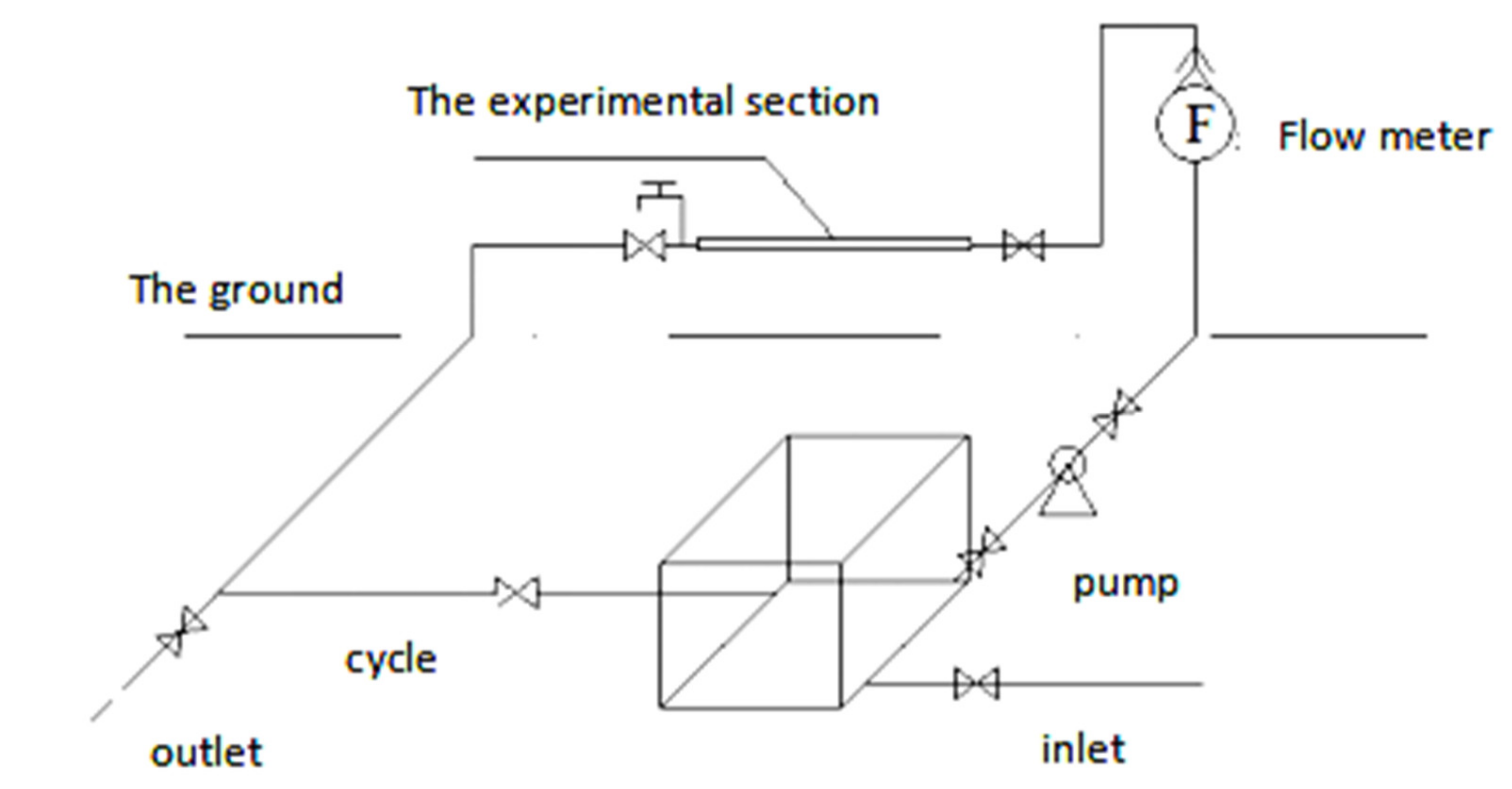
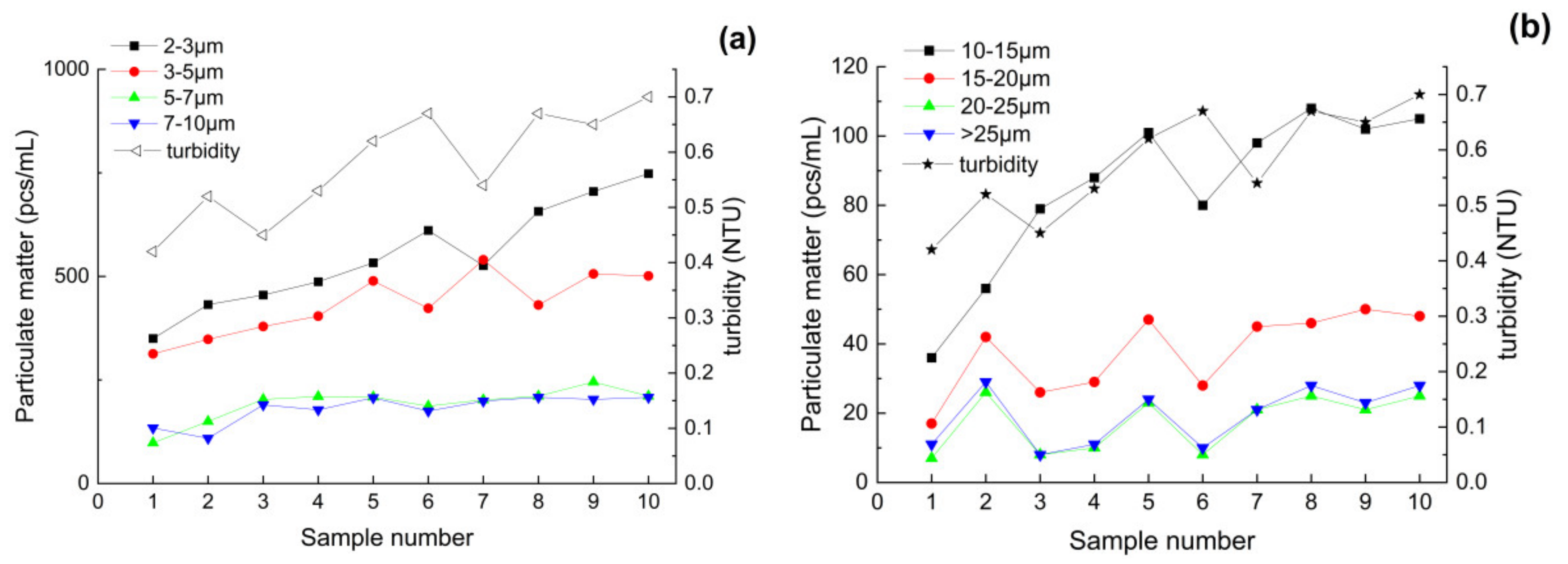
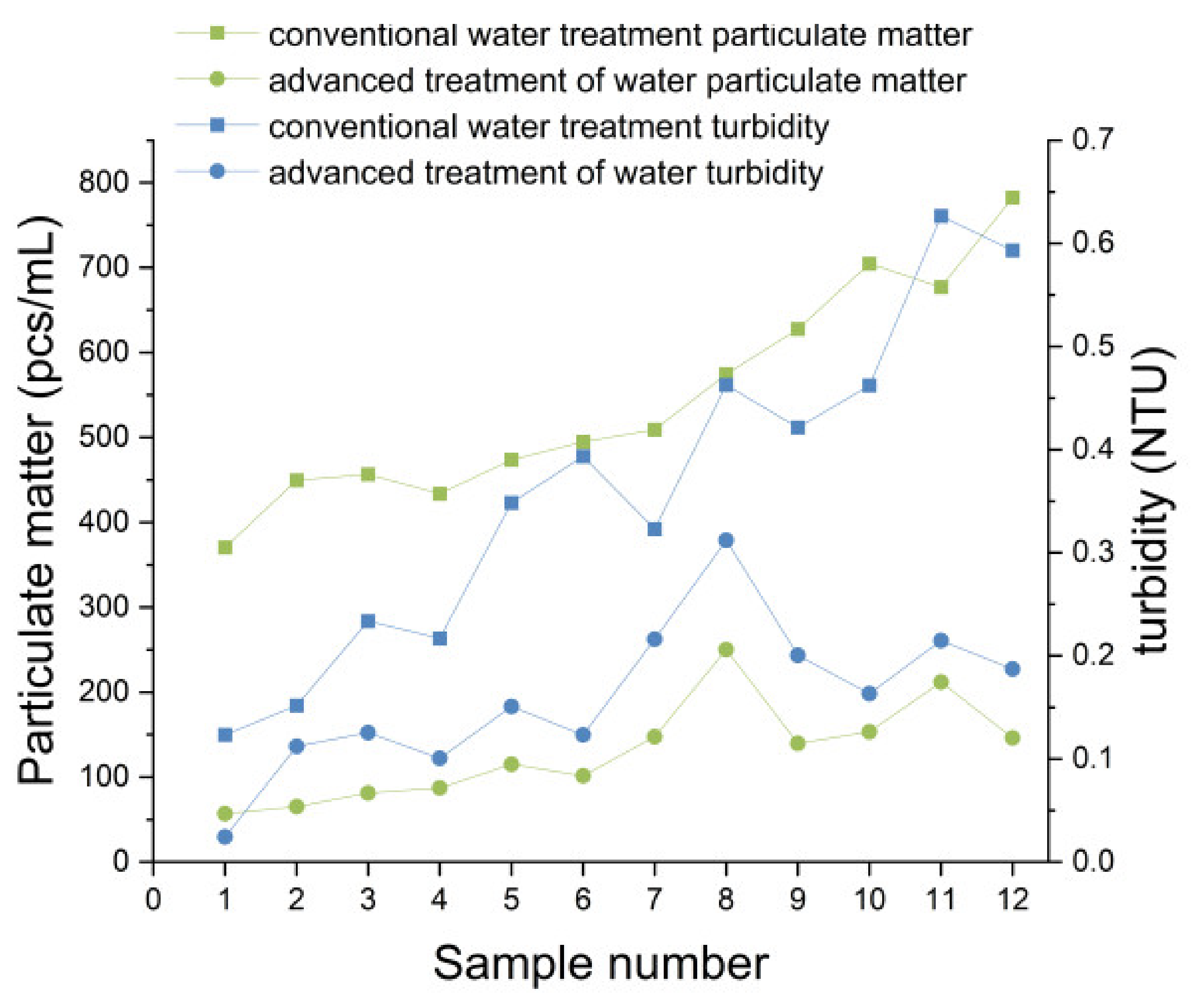
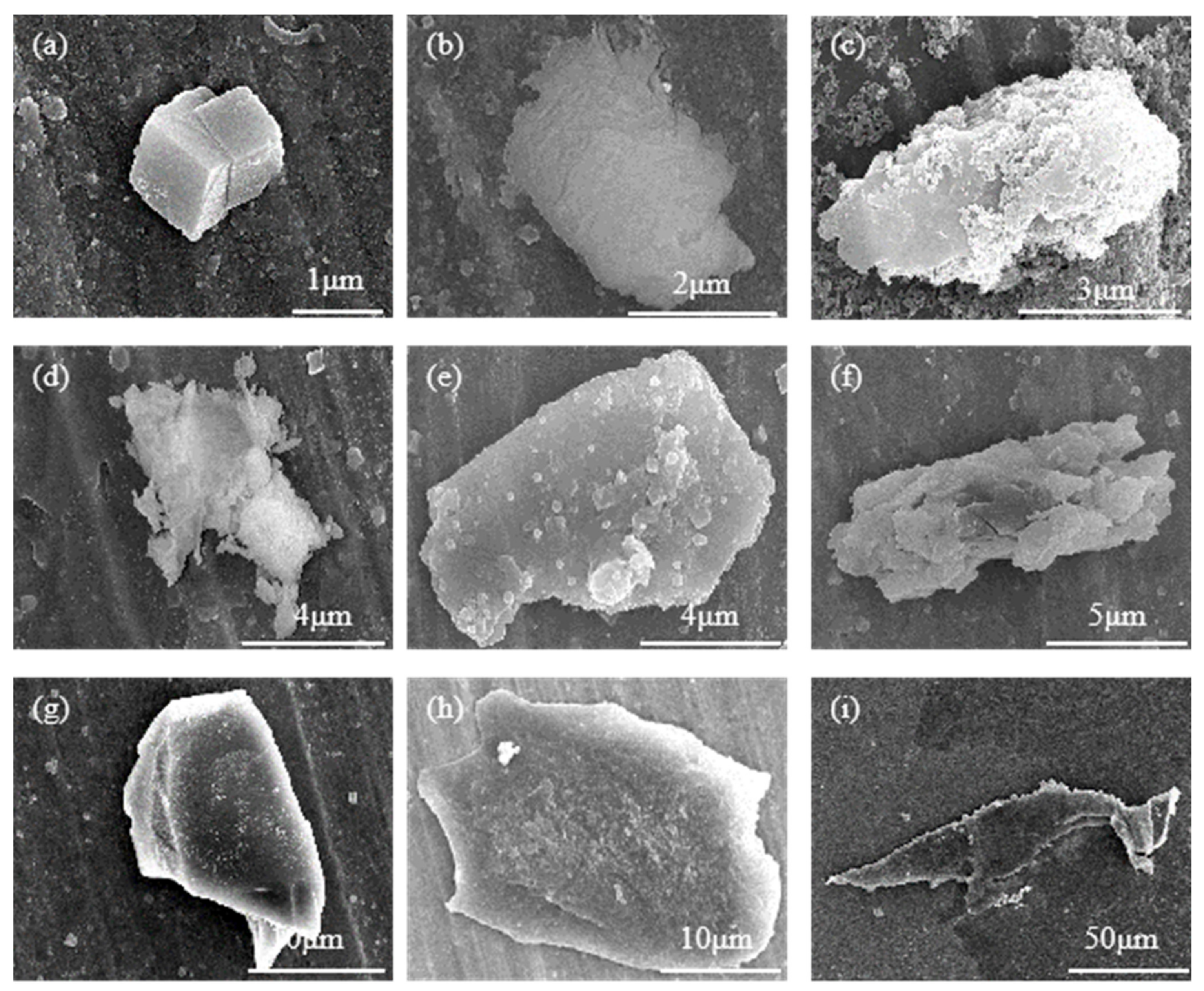

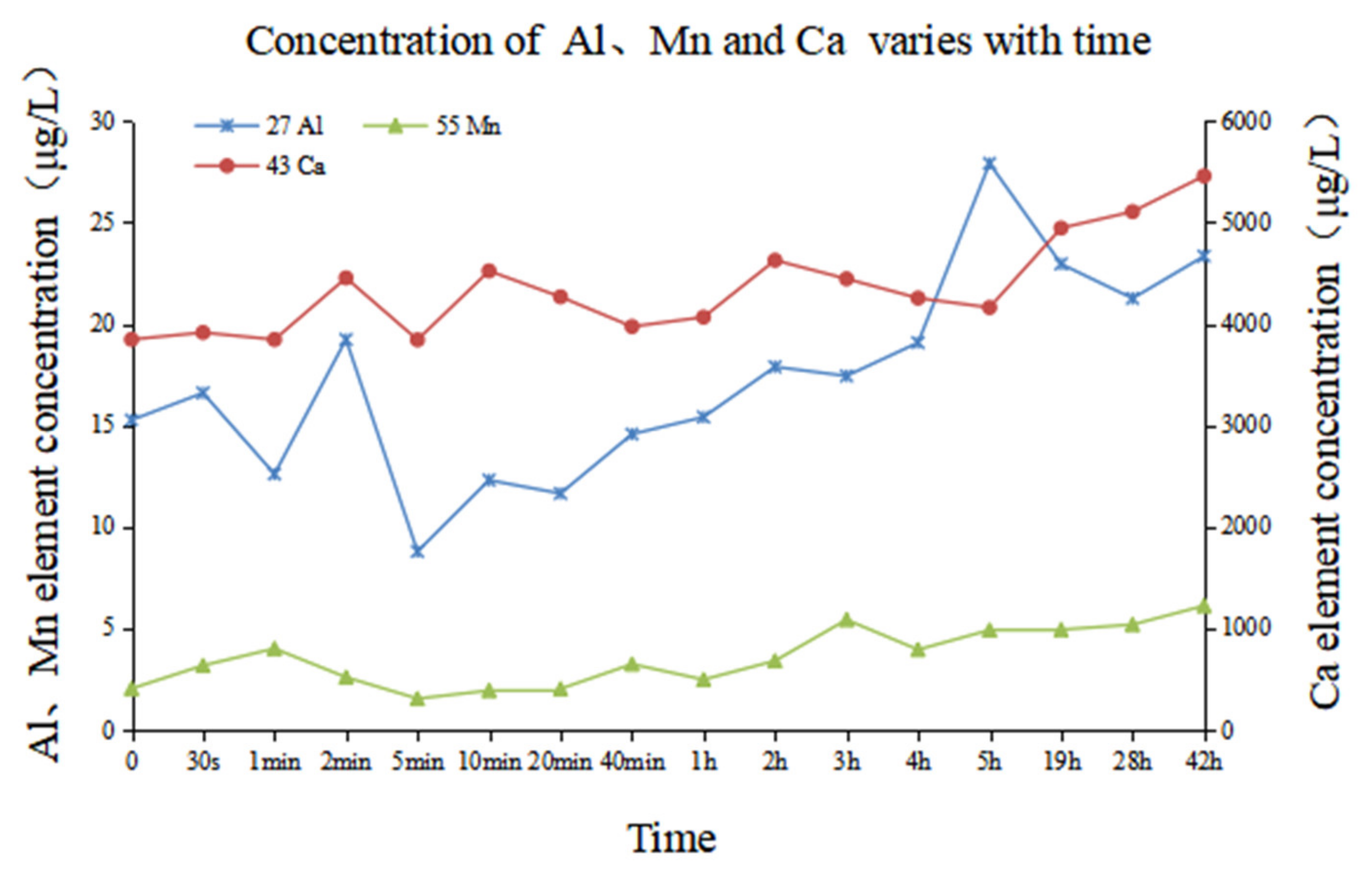

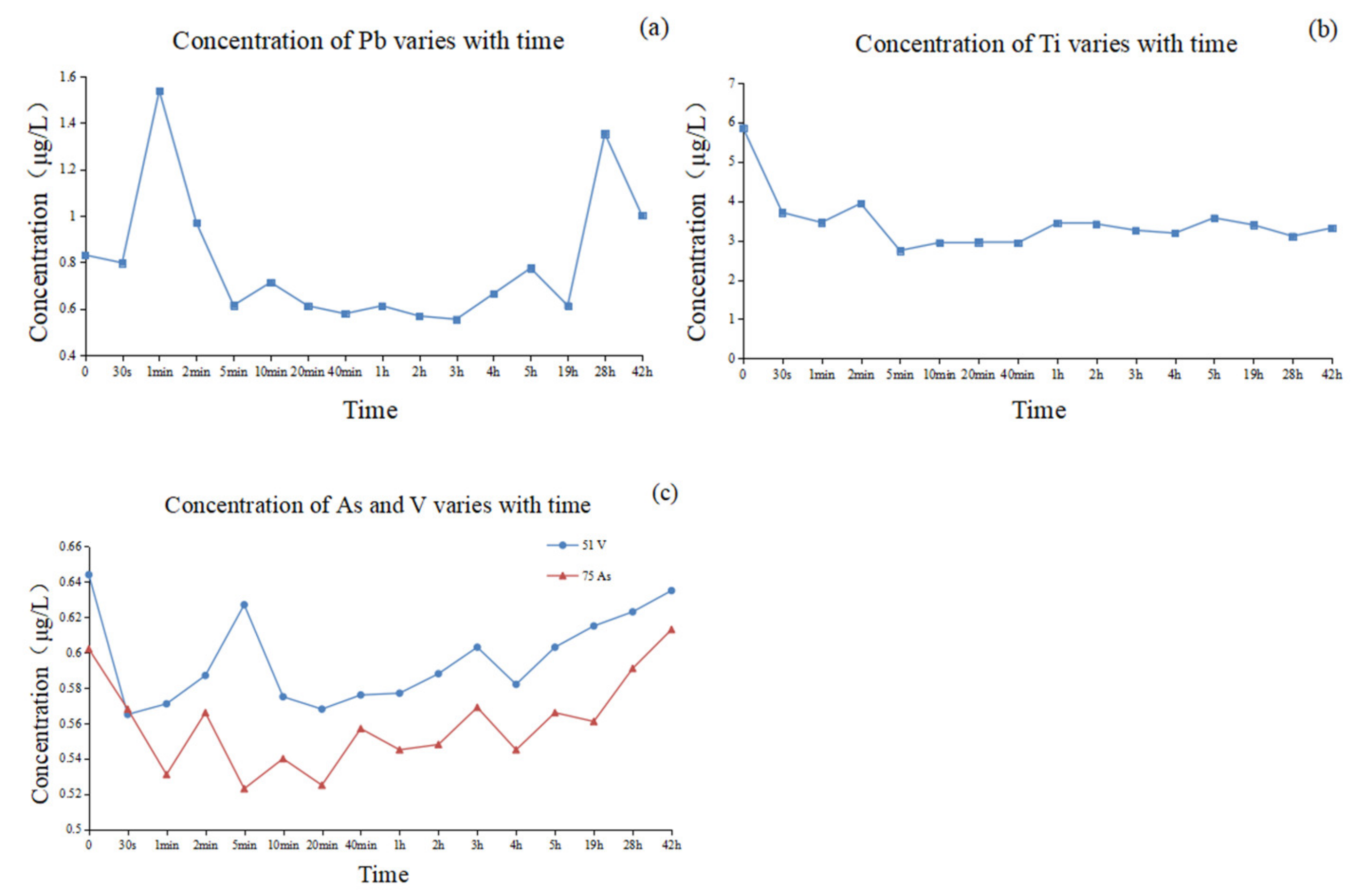


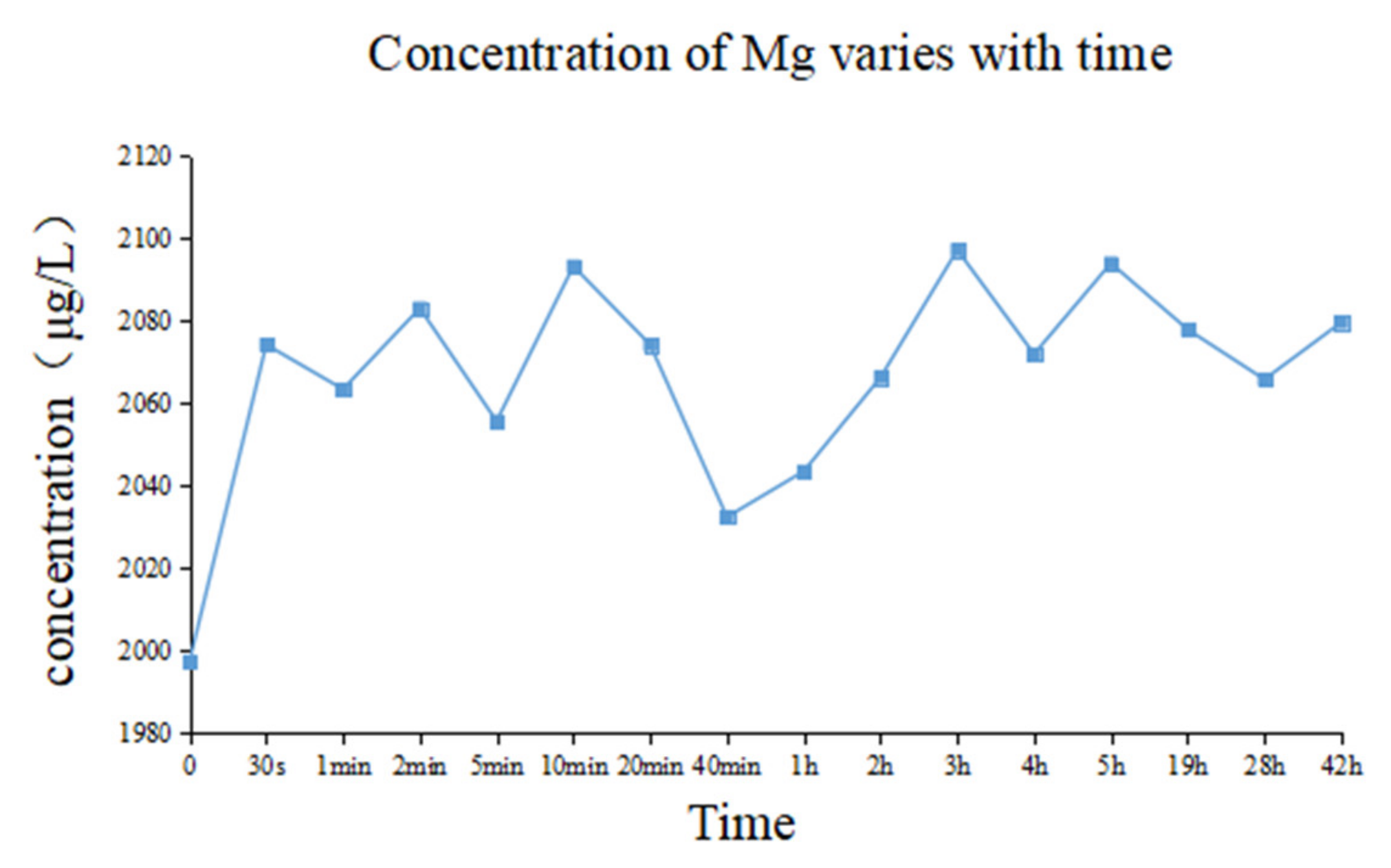
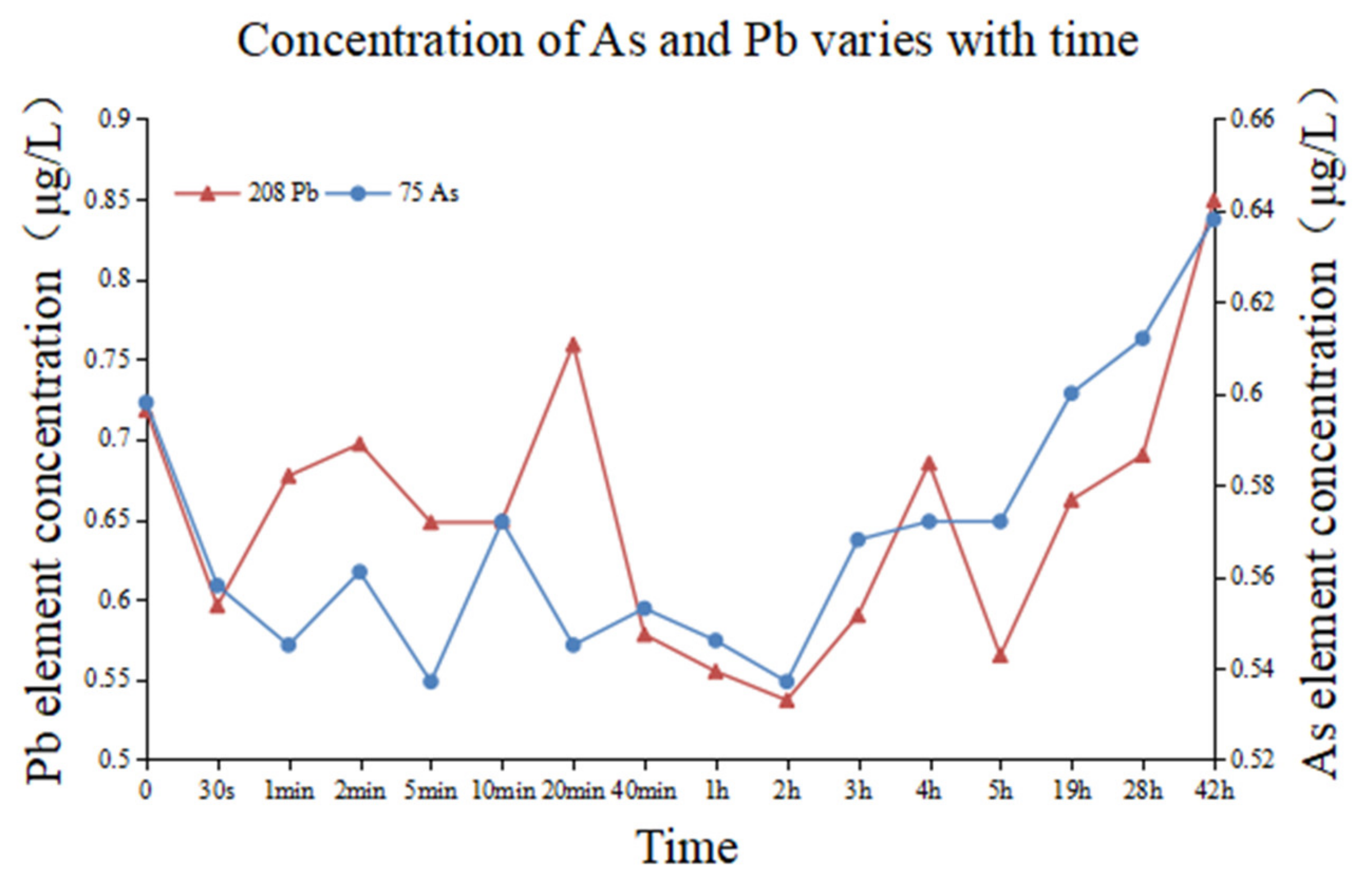

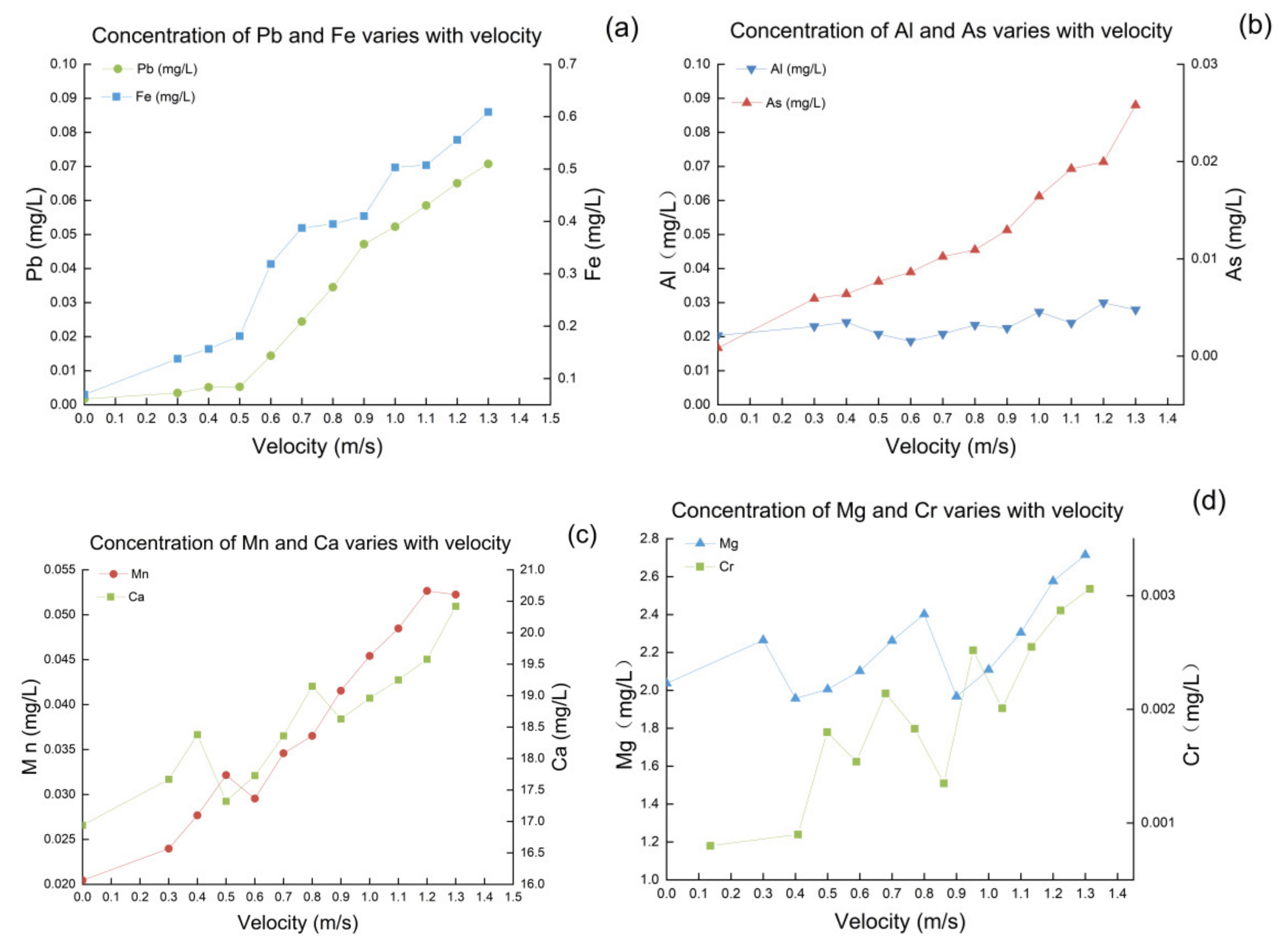
| The Molar Proportion of Each Element in a 2-3 Micron Particle (%) | ||||||||
|---|---|---|---|---|---|---|---|---|
| Element Sample | T-1 | T-2 | T-3 | T-4 | T-5 | T-6 | T-7 | T-8 |
| Ca | 39.12 | 24.35 | 29.83 | 31.02 | 8.74 | 22.57 | 33.24 | |
| Si | 4.36 | 6.31 | 13.6 | 33.31 | 22.86 | 17.22 | 5.28 | |
| Al | 28.29 | 19.05 | 13.37 | |||||
| Mg | 3.05 | 3.56 | 2.26 | 1.96 | 4.46 | |||
| Fe | 2.27 | |||||||
| K | 1.63 | 6 | 1.17 | |||||
| Na | 17.44 | |||||||
| C | 5.31 | 2.22 | 3.38 | 2.86 | 4.69 | 4.26 | 5.65 | 6.96 |
| Cl | 1.85 | 2.69 | 14.68 | 1.49 | 4.13 | |||
| F | 63.85 | |||||||
| Mo | 15.99 | |||||||
| La | 0.68 | |||||||
| Pd | 0.24 | 0.4 | ||||||
| Ti | 2 | |||||||
| V | 0.54 | |||||||
Publisher’s Note: MDPI stays neutral with regard to jurisdictional claims in published maps and institutional affiliations. |
© 2022 by the authors. Licensee MDPI, Basel, Switzerland. This article is an open access article distributed under the terms and conditions of the Creative Commons Attribution (CC BY) license (https://creativecommons.org/licenses/by/4.0/).
Share and Cite
Zhao, Z.; Wang, L.; Shi, W.; Li, C.; Wei, G. Motion Adsorption Characteristics of Particulate Matter in Water Supply Network. Water 2022, 14, 3550. https://doi.org/10.3390/w14213550
Zhao Z, Wang L, Shi W, Li C, Wei G. Motion Adsorption Characteristics of Particulate Matter in Water Supply Network. Water. 2022; 14(21):3550. https://doi.org/10.3390/w14213550
Chicago/Turabian StyleZhao, Zhiling, Lu Wang, Wenhang Shi, Cong Li, and Guozijian Wei. 2022. "Motion Adsorption Characteristics of Particulate Matter in Water Supply Network" Water 14, no. 21: 3550. https://doi.org/10.3390/w14213550
APA StyleZhao, Z., Wang, L., Shi, W., Li, C., & Wei, G. (2022). Motion Adsorption Characteristics of Particulate Matter in Water Supply Network. Water, 14(21), 3550. https://doi.org/10.3390/w14213550






